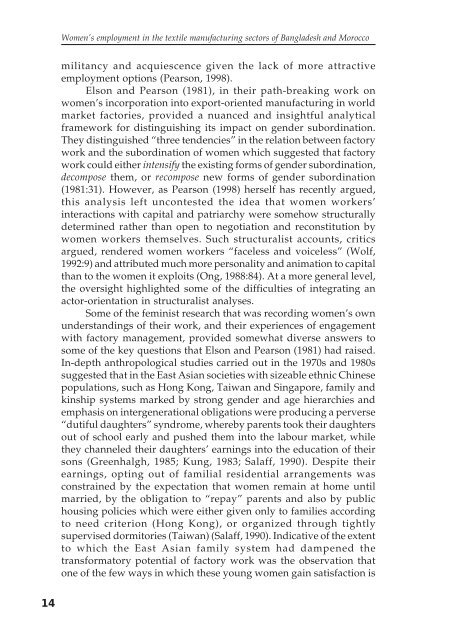Women's Employment - United Nations Research Institute for Social ...
Women's Employment - United Nations Research Institute for Social ...
Women's Employment - United Nations Research Institute for Social ...
Create successful ePaper yourself
Turn your PDF publications into a flip-book with our unique Google optimized e-Paper software.
Women’s employment in the textile manufacturing sectors of Bangladesh and Morocco<br />
militancy and acquiescence given the lack of more attractive<br />
employment options (Pearson, 1998).<br />
Elson and Pearson (1981), in their path-breaking work on<br />
women’s incorporation into export-oriented manufacturing in world<br />
market factories, provided a nuanced and insightful analytical<br />
framework <strong>for</strong> distinguishing its impact on gender subordination.<br />
They distinguished “three tendencies” in the relation between factory<br />
work and the subordination of women which suggested that factory<br />
work could either intensify the existing <strong>for</strong>ms of gender subordination,<br />
decompose them, or recompose new <strong>for</strong>ms of gender subordination<br />
(1981:31). However, as Pearson (1998) herself has recently argued,<br />
this analysis left uncontested the idea that women workers’<br />
interactions with capital and patriarchy were somehow structurally<br />
determined rather than open to negotiation and reconstitution by<br />
women workers themselves. Such structuralist accounts, critics<br />
argued, rendered women workers “faceless and voiceless” (Wolf,<br />
1992:9) and attributed much more personality and animation to capital<br />
than to the women it exploits (Ong, 1988:84). At a more general level,<br />
the oversight highlighted some of the difficulties of integrating an<br />
actor-orientation in structuralist analyses.<br />
Some of the feminist research that was recording women’s own<br />
understandings of their work, and their experiences of engagement<br />
with factory management, provided somewhat diverse answers to<br />
some of the key questions that Elson and Pearson (1981) had raised.<br />
In-depth anthropological studies carried out in the 1970s and 1980s<br />
suggested that in the East Asian societies with sizeable ethnic Chinese<br />
populations, such as Hong Kong, Taiwan and Singapore, family and<br />
kinship systems marked by strong gender and age hierarchies and<br />
emphasis on intergenerational obligations were producing a perverse<br />
“dutiful daughters” syndrome, whereby parents took their daughters<br />
out of school early and pushed them into the labour market, while<br />
they channeled their daughters’ earnings into the education of their<br />
sons (Greenhalgh, 1985; Kung, 1983; Salaff, 1990). Despite their<br />
earnings, opting out of familial residential arrangements was<br />
constrained by the expectation that women remain at home until<br />
married, by the obligation to “repay” parents and also by public<br />
housing policies which were either given only to families according<br />
to need criterion (Hong Kong), or organized through tightly<br />
supervised dormitories (Taiwan) (Salaff, 1990). Indicative of the extent<br />
to which the East Asian family system had dampened the<br />
trans<strong>for</strong>matory potential of factory work was the observation that<br />
one of the few ways in which these young women gain satisfaction is<br />
14
















